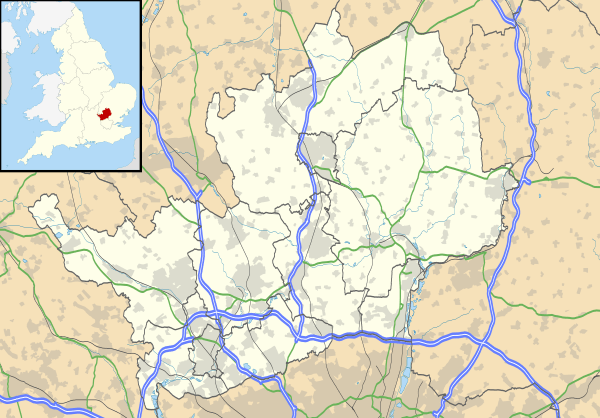Digswell
Digswell is an ancient village in the English county of Hertfordshire which is recorded in the 1086 Domesday Book.[2] Its population in the 2011 Census was 1,632.[1]
| Digswell | |
|---|---|
 Digswell Location within Hertfordshire | |
| Population | 1,632 (2011)[1] |
| OS grid reference | TL249155 |
| Civil parish |
|
| District | |
| Shire county | |
| Region | |
| Country | England |
| Sovereign state | United Kingdom |
| Post town | WELWYN |
| Postcode district | AL6 |
| Dialling code | 01438 |
| Police | Hertfordshire |
| Fire | Hertfordshire |
| Ambulance | East of England |
| UK Parliament | |
Digswell's name may be derived from Deacon's Well.[3] There were two Manors, with 2 water Mills, much land under plough, and a large area of woodland. Little changed until 1922 when part of the estate once belonging to Lord Cowper of Panshanger was sold at auction, and bought by a group of pioneers of the Garden City Movement including Ebenezer Howard. On this land which included much of the old Parish of Digswell and further acquisitions nearby, was built Welwyn Garden City. The name Digswell is now used to describe an essentially 20th-century residential area centred on Welwyn North railway station, on the northern outskirts of the original Parish, but the Church of St John the Evangelist (13th century, much altered) (3) and the 19th-century Digswell House built on the site of a much earlier residence still mark the original centre. The impressive Digswell Viaduct built by William Cubitt in 1850 carries the Great Northern Railway over the valley of the River Mimram (River Maran) on some 40 brick arches.[4] The residential workshop for sculptors, artists and musicians sponsored by the Digswell Arts Trust, was once located in Digswell House.[5] Part of the southern Parish Boundary Baulk (raised bank) between the ecclesiastical parishes of Digswell and Hatfield may still be seen in Sherrardspark Wood, a local woodland, nature reserve and Site of Special Scientific Interest.(5) Much of Digswell is now part of the borough of Welwyn and Hatfield.
The present Digswell local residential area centred on Welwyn North station has a population of about 1600, with a shop or two, and a pub called the Cowper Arms. Notable past residents here include Kenneth Allsop, Alan Brazil, Graham Richard James, the police reformer Sir Arthur Young, H.G. Wells and American actor Barry Chapman. When first developed, this residential area was known as "High Welwyn"[6] before later taking on the name of the old parish on the south side of the nearby Hertford Road.
Further reading
- Dora Ward, 'Digswell from Domesday to Garden City' first published 1953 and since reprinted.
References
- "Mid-2011 population estimates". Office for National Statistics. March 2011. Archived from the original on 2 April 2015. Retrieved 26 March 2015.
- 'Domesday Book, 12 Hertfordshire', ed. John Morris, publ. Phillimore 1976, in the 'History from the Sources' series.
- Rev. Professor Skeat The Place Names of Hertfordshire East Herts Archaeological Society 1904
- Nikolaus Pevsner, Buildings of England BE 7, Hertfordshire, first publ. Penguin 1953
- Richard J Busby 'The Book of Welwyn" Barracuda Books 1986
- Tony Rook 'River Mimram' Amberley Publishing Limited 2014 - chapter 7